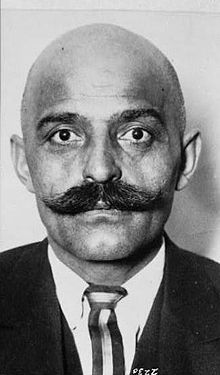George Gurdjieff | |
|---|---|
 Gurdjieff between 1925 and 1935 | |
| Born | George Ivanovich Gurdjieff 1867 |
| Died | 29 October 1949 Neuilly-sur-Seine, France |
| School | Fourth Way |
| Notable students | |
Main interests | |
Notable ideas | |
George Ivanovich Gurdjieff (c. 1867 – 29 October 1949)[1] was a Greek–Armenian philosopher, mystic, spiritual teacher, composer, and movements teacher.[2] Gurdjieff taught that people are not conscious of themselves and thus live their lives in a state of hypnotic "waking sleep", but that it is possible to awaken to a higher state of consciousness and serve our purpose as human beings. The practice of his teaching has become known as "The Work"[3] (connoting work on oneself) and is additional to the ways of the Fakirs (Sufis), Monks and Yogis, so that his student P. D. Ouspensky referred to it as the "Fourth Way".[4]
Gurdjieff's teaching has inspired the formation of many groups around the world. After his death in 1949, the Gurdjieff Foundation in Paris was established and led by his close pupil Jeanne de Salzmann in cooperation with other direct pupils of Gurdjieff, until her death in 1990; and then by her son Michel de Salzmann, until his death in 2001.
The International Association of the Gurdjieff Foundations[5] comprises the Institut Gurdjieff in France; The Gurdjieff Foundation in the USA; The Gurdjieff Society in the UK; and the Gurdjieff Foundation in Venezuela.
- ^ According to his own account Gurdjieff was born in 1867. He told a group meeting on Thursday 28/10/1943 that he was then 76 years old. He died six years later in 1949 when he was 82 years old – and certainly looked this age from photographs and videos taken at that time. His age also reflects what he said in his autobiography "Meetings with Remarkable Men" – that he was about 7 years old at the time of the great cattle plague which affected his father's livestock. This event occurred in the summer of 1873. In the same chapter he recalls his childhood in the "1870's". Various documents and other authors such as James Webb, The Harmonious Circle, Thames and Hudson, 1980, pp. 25–26 provides a range of dates from 1872, 1873, 1874, 1877 to 1886.
- ^ http://www.cambridgescholars.com/download/sample/58952 Archived 2019-09-18 at the Wayback Machine Cambridge Scholars Publishing. Edited by Michael Pittman. G. I. Gurdjieff: Armenian Roots, Global Branches. During the early period after Gurdjieff's arrival in Europe in 1921 he gained significant notoriety in Europe and the United States... In October 1922, Gurdjieff set up a school at the Prieuré des Basses Loges at Fontainebleau-Avon, outside of Paris. It was at the Prieuré that Gurdjieff met many notable figures, authors, and artists of the early twentieth century, many of whom went on to be close students and exponents of his teaching. Over the course of his life, those who visited and worked with him included the French author René Daumal; the renowned short story author from New Zealand, Katherine Mansfield; Kathryn Hulme, later the author of A Nun's Life; P. L. Travers, the author of Mary Poppins; and Jean Toomer, the author of Cane, whose work and influence would figure prominently in the Harlem Renaissance... Numerous study groups, organizations, formal foundations, and even land-based communities have been initiated in his name, primarily in North and South America and Europe, and to a lesser extent, in Japan, China, India, Australia, and South Africa. In 1979, Peter Brook, the British theater director and author, created a film based on Meetings with Remarkable Men.
- ^ Ouspensky, P. D. (1977). In Search of the Miraculous. Harcourt, Brace. pp. 312–313. ISBN 0-15-644508-5.
Schools of the fourth way exist for the needs of the work... But no matter what the fundamental aim of the work is ... When the work is done the schools close.
- ^ "Gurdjieff International Review". Gurdjieff.org. Retrieved 2 March 2014.
- ^ "International Association of the Gurdjieff Foundations". www.institut-gurdjieff.com. Retrieved 4 December 2022.